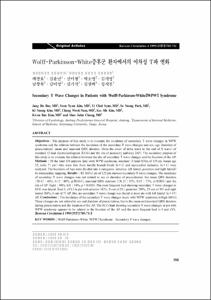KUMEL Repository
1. Journal Papers (연구논문)
1. School of Medicine (의과대학)
Dept. of Internal Medicine (내과학)
Wolff-Parkinson-White증후군 환자에서의 이차성 T파 변화
- Alternative Author(s)
- Kim, Yoon Nyun; Nam, Chang Wook; Kim, Kee Sik; Kim, Kwon Bae; Kim, Mi Jeong
- Journal Title
- 순환기
- ISSN
- 1225-164X
- Issued Date
- 1999
- Abstract
- Objectives:The purpose of this study is to evaluate the incidence of secondary T wave changes in WPW
syndrome and the relation between the incidence of the secondary T wave changes and sex, age (duration of
preexcitation), mean and maximal QRS duration (from the onset of delta wave to the end of S wave) of
standard 12 lead electrocardiogram (ECG) and the site of accessory pathway (AP). The secondary purpose of
this study is to evaluate the relation between the site of secondary T wave changes and the location of the AP.
Methods:Of the total 128 patients (pts) with WPW syndrome, standard 12 lead ECGs of 125 pts (mean age
35, male 71 pts) who were free from bundle branch block (n=2) and myocardial ischemia (n=1) were
analyzed. The locations of Aps were divided into 4 categories (anterior, left lateral, posterior and right lateral)
by intracardiac mapping. Results:82 (66%) pts of 125 pts showed secondary T wave changes. The incidence
of secondary T wave changes was not related to sex or duration of preexcitation, but mean QRS duration
(<0.12:46%, 0.12:88%, p<0.001), maximal QRS duration (<0.12:32%, 0.12:73%, p<0.001) and the
site of AP (right:80%, left:54%, p=0.003). The most frequent lead showing secondary T wave changes in
ECG was lateral (lead I, aVL) in pts with anterior (43%, 9 out of 21), posterior (50%, 25 out of 50) and right
lateral (86%, 6 out of 7) AP. But, no secondary T wave change was found in most pts with left lateral (n=47)
AP. Conclusions:The incidence of the secondary T wave changes in pts with WPW syndrome is high (66%).
These changes are not related to sex and duration of preexcitation, but to the mean and maximal QRS duration
during preexcitation and the location of the AP. The ECG lead showing secondary T wave changes in pts with
WPW syndrome appears to be related to the location of the AP and the most frequent lead is I and aVL.
(Korean Circulation J 1999;29(7):705-711)
WPW증후군은 심전도상 동성 율동시 PR간격의 단
축, QRS시작부위의 완만(delta파), QRS기간의 연장과
delta파나 QRS파 벡터의 방향과 반대 방향의 이차성
ST-T파 변화로 특징지워지는데,1) 이 때 이차성 STT파의
변화는 QRS기간이 길지 않을 때는 명확히 나타
나지 않을 수 있으며 A형인 경우 전흉부 유도 V1-3
에서, B형인 경우에는 전흉부 유도 V4-6에서 흔히 나
타난다고 한다.2) 그러나, 이차성 T파 변화의 빈도나
부전도로의 위치와 이차성 T파 변화 부위와의 상관 관
계에 대해서는 아직 잘 알려져 있지 않은 실정이며,
WPW증후군의 과거 분류법인 A형과 B형은 이에 속하
지 않는 WPW증후군이 많이 있고2) 최근에는 잘 사용
되고 있지는 않다.
그러므로 WPW증후군환자의 심전도에서 보일 수 있
는 이차성 T파 변화에 대한 연구 분석이 필요한 실정
이며 이런 분석은 WPW증후군의 전극 도자 절제술 후
보이는 T파 역전을 설명하는‘Cardiac Memory’의
이해에도 도움이 되리라 생각된다.
이에 저자등은 WPW증후군이 있을 때 이런 이차성
T파 변화가 심전도의 어느 유도에서 어느 정도의 빈도
로 나타나는 지 그리고, 연령별, 성별, 심실 조기 흥분
시 QRS기간 혹은 부전도로의 위치에 따른 이차성 T파
변화의 빈도를 알아보고 부전도로의 위치에 따른 이차
성 T파 변화가 생기는 심전도 유도의 분포에 대한 상
관관계를 알아보기 위하여 이 연구를 시행하였다.
- Alternative Title
- Secondary T Wave Changes in Patients with Wolff-Parkinson-White(WPW) Syndrome
- Publisher
- School of Medicine
- Citation
- 김기식 et al. (1999). Wolff-Parkinson-White증후군 환자에서의 이차성 T파 변화. 순환기, 29(7), 705–711. doi: 10.4070/kcj.1999.29.7.705
- Type
- Article
- ISSN
- 1225-164X
- Appears in Collections:
- 1. School of Medicine (의과대학) > Dept. of Internal Medicine (내과학)
1. School of Medicine (의과대학) > Dept. of Radiology (영상의학)
- 파일 목록
-
-
Download
 oak-bbb-4635.pdf
기타 데이터 / 3.48 MB / Adobe PDF
oak-bbb-4635.pdf
기타 데이터 / 3.48 MB / Adobe PDF
-
Items in Repository are protected by copyright, with all rights reserved, unless otherwise indicated.